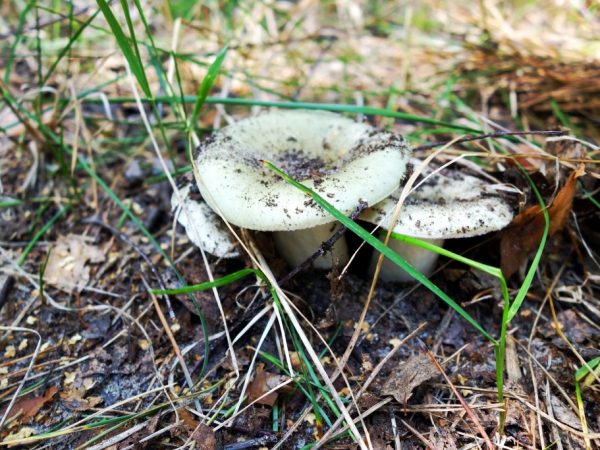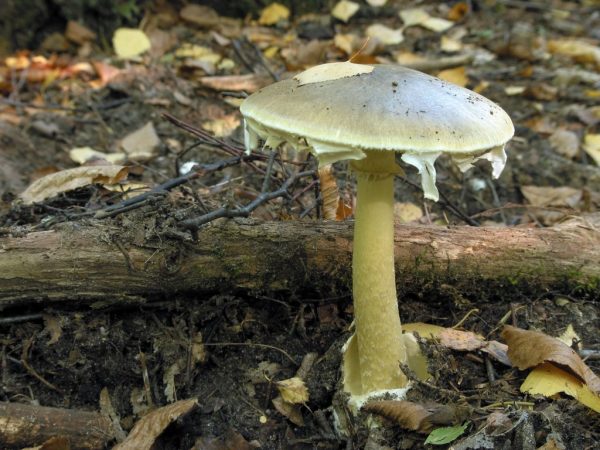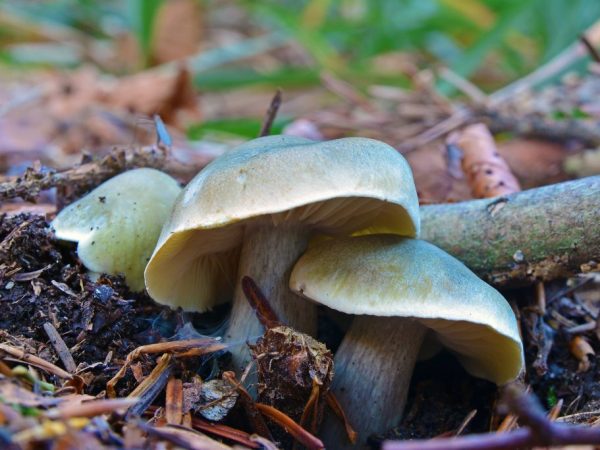What are the features of greenfinch mushroom twins
In the common people, ryadovka is called green tea or brilliant green because of such a very unusual shade of its fruiting body. She belongs to the Ryadovka genus, whose representatives are included in the 4th edible category. Sometimes the greenfinch mushroom double is confused with the original.

Doubles of the mushroom Zelenushka
General description of twins
Almost all noble and edible forest mushrooms have their own poisonous or conditionally edible "brothers". The presence of such twins in greenfinch is no exception. The common distinguishing quality of the twins is the presence in them of a large amount of toxins, which, when entering the human body, lead to serious consequences, sometimes to death.
The action of toxic substances is divided into 3 categories:
- Intoxication of the food system.
- Damage to the nervous system.
- Fatal poisoning.
It is not always possible to recognize toxic organisms by external primary signs. In the fly agaric, the white spots on the cap are washed out after rain, and it becomes very similar to a red russula. The honey fungus is false, trying to disguise itself as an ordinary one, and hides the "skirt" higher (it is placed very close to the cap) on its leg.
Another common feature of poisonous twins is a change in the color of the pulp at the break.
To avoid unpleasant consequences, before going into the forest, you should carefully study the varieties of edible mushrooms and their counterparts.
Views
The false brothers of greenfinch have many names, these include:
- death cap;
- the row is golden;
- the row is sultry;
- detached rowing;
- the row is sulfuric;
- the row is soapy.
The only edible counterpart is the green russula (Russula aeruginea). So it was named because of the color of the upper skin (the surface of the cap). The difference lies in the yellow plates under the cap and fragile pulp.
Death cap
Pale toadstool is the most dangerous mushroom of all false greenfinch species and, perhaps, not only in Russia. The Latin name is Amanita phalloides. This species belongs to the genus Amanita.
Description:
- the size of the surface of the cap is 10-15 cm;
- the color of the cap is pale olive;
- the skin is smooth;
- convex shape;
- the plates are white;
- the pulp is greenish;
- the leg is not thick, up to 20 cm high;
- the color of the leg is white, streaked.

Mushrooms can cause severe poisoning
The young convex surface gradually becomes flatter with age, in its center is a pale beige dot. A distinctive feature of this mushroom is a film ring under the cap and a saccular volva at the base of the stem. It is often immersed in almost half of the soil.
Row golden
The row is golden, or more precisely - the brown-yellow talker (Clitocybe gilva) refers to inedible doubles. It is common in conifers. The crop gives from July to the end of October. Her description:
- the surface of the cap is convex, with thin curved edges;
- the surface is smooth;
- cap diameter - up to 10 cm;
- yellow-milky color;
- leg up to 5-6 cm in height;
- leg thickness - up to 5 mm;
- the shape of the leg is curved;
- the structure of the stem is fibrous;
- the color of the leg is yellow;
- plates are dark yellow;
- the pulp is dense;
- the color of the pulp is cream;
- uncharacteristic aroma, medicinal (smells like anise).
The peculiarity of this species is the presence of reddish spots on the watery surface of the cap and bitter powdery pulp.
The row is sultry
Tricholoma aestuans, or sultry spruce, has a much smaller size and a disgusting smell. The taste immediately betrays the inedibility of the sultry ryadovka. In appearance, it strongly resembles the original:
- size (diameter) of the cap - from 3 cm to 10 cm;
- a bell-shaped hat;
- the taste is pungent, pungent, bitter;
- brownish color.
The difference from the edible ryadovka consists in the density of the pulp of the leg and the unpleasant watery pulp of the cap. Scaly formations are visible on the surface of the cap.
Sultry ryadovka forms mycorrhiza with spruces and pines, in damp areas of the forest.
The row is soapy

Soapy row can not be eaten
Tricholoma saponaceum, Agaricus saponaceum, or soap ryadovka, has a bright unpleasant taste and a characteristic soapy-fruity aroma, which cannot be eliminated even with careful washing and cooking. This inedible species has a smooth, pale olive-colored cap that may have a reddish-brown patch in the middle.
The diameter of its cap is average - 5-10 cm. The hymenophore is lamellar, represented by thin and rare yellowish plates.
A distinctive feature is lilac spots on the plates and red spots on the legs, which rise up 110-112 cm.
The flesh of a soapy appearance is dense, slightly yellowish.
Irina Selyutina (Biologist):
It is not for nothing that the soap ridge got its name - it is the soapy smell, the pulp that turns red on the cut and the strong bitter taste that serve as reliable characteristics that make it possible to distinguish it from edible species. However, you should still be extremely careful during the collection, because it can be confused with a green ryadovka and a brown ryadovka.
Representatives of this species grow - mycorrhiza formers, found in broad-leaved and coniferous (less often mixed) forests, under pines and spruces, beeches or oaks.
Row sulfur
Sulfuric, or sulfur-yellow, ryadovka belongs to the weakly venomous species. Its toxins do not cause death, only a slight poisoning is possible, which goes away on its own a few hours after the sulfur ryadovka enters the food, provided that a large amount of liquid is taken.
Description:
- the fruiting body is gray or yellow;
- the surface of the cap is velvety;
- cap diameter - up to 9 cm;
- the shape of the cap is convex;
- leg up to 11 cm high;
- the shape of the leg is conical;
- the pulp is dense and bitter;
- the aroma is pungent, reminiscent of hydrogen sulfide (rotten egg).
In old mushrooms, the top of the cap becomes flat, and a fossa appears in its center. Small scales or patterns are visible at the base of the stem. Mushrooms do well next to oak or beech trees. Harvest from late August to late October.
Harm and contraindications
Edible greenfinches belong to the 4th flavor category, which requires special preparation.
Inedible and poisonous food is contraindicated to eat, but this can happen by accident. There have been many fatal cases of poisoning with these species.
An interesting feature has been noticed. Depending on the climatic zone in which the species grows, its toxicity increases or decreases. In a warm climate, toxic substances are much more active and stronger on the human body.
When harvesting, precautions should be taken and carefully sorted out so that dangerous poisonous twins of greenfinch do not get into the finished dish.
Before starting the main cooking, it is important to wash everything well in clean running water. Remove dirt, adhering leaves and discard suspicious specimens.
Onions or garlic do not always react to toxins contained in representatives of poisonous species, which are recommended to be thrown into a saucepan during cooking.
You should not risk your health and life. A small piece of a poisonous mushroom can cause convulsions, hallucinations, vomiting, dizziness and diarrhea in a person.
If these symptoms occur, it is important to immediately rinse the stomach with plenty of water and then call a doctor.
Since ryadovki, like other mushrooms, are capable of accumulating various compounds in their bodies, including salts of heavy metals, therefore, it is impossible to collect and eat old overgrown specimens. Abuse of mushroom dishes can lead to flatulence, the development of painful sensations in the abdomen. Rows are also contraindicated for those who suffer from low acidity of gastric juice, chronic problems of the gastrointestinal tract, gallbladder, as well as the presence of pancreatitis and cholecystitis, children under 7 years old.
Application
Edible greenfinches, or ryadovki, are used in cooking and medicine. They make excellent pickles, pates and seasonings. Many people compare the taste of ryadovki with the taste of boiled meat. They can be used as a side dish for omelets and meat. Pre-cleaned rows are cooked and washed in running water for 20 minutes.
Irina Selyutina (Biologist):
From the enzymes contained in the rows, antibiotics are obtained that can be used in the fight against tuberculosis. Also in the body of the fungus there are many B vitamins (especially B1 and in2), also PP, C and A. Among the trace elements are copper, zinc and manganese - which is important for vegetarians. These mushrooms are recommended for those suffering from diabetes and hypertension. As a low-calorie product (19 kcal per 100 g of product), they can be used in dietary meals.
Pharmacists make drugs based on them that help restore blood sugar levels, stabilize blood pressure and the functioning of the gastrointestinal tract.
The healing properties of inedible and poisonous ryadovki are not fully understood. But bactericidal ointments are also prepared from them, which heal purulent wounds, burns and help well with frostbite, because these organisms contain a large number of natural antibiotics.
The hallucinogenic properties of mushrooms are used to treat severe nervous and mental disorders. The chemical composition of alkaloids and a large amount of psilobicin have a positive effect on the brain cells of the patient.
In Japan, a powder is made from some types of ryadovki, which is used in cosmetology to improve complexion, tighten wrinkles and to remove acne or reduce oily skin.
Conclusion
It is worthwhile to be responsible for picking mushrooms and not to pluck everything that comes across on the way. Rows, or brilliant greens, have more than 2500 varieties, but you can eat only 6-7. They grow throughout Russia.



